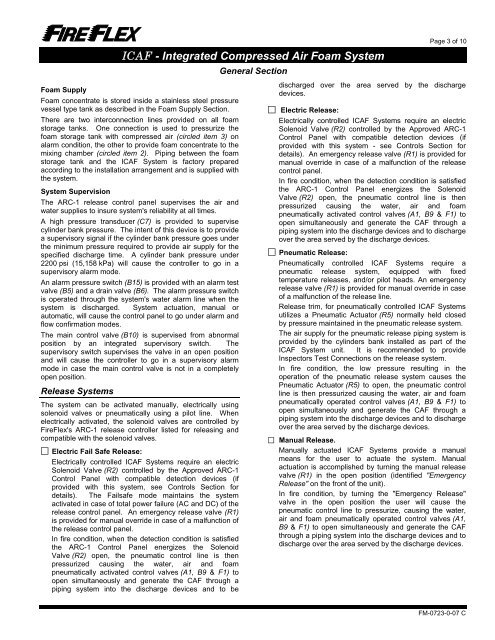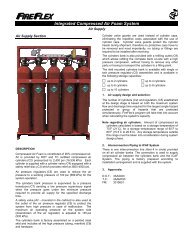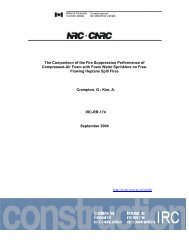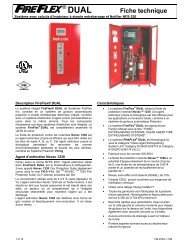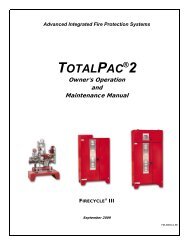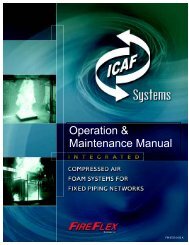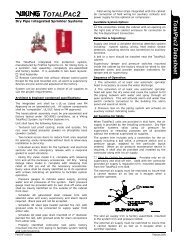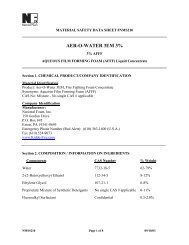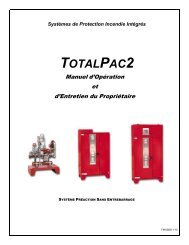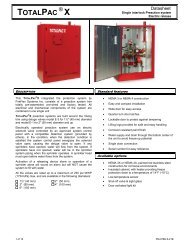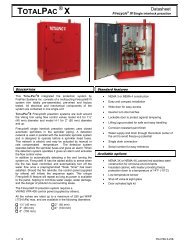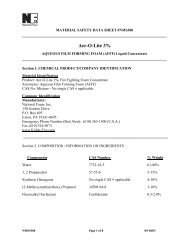ICAF System with pneumatic release - Fireflex.com
ICAF System with pneumatic release - Fireflex.com
ICAF System with pneumatic release - Fireflex.com
You also want an ePaper? Increase the reach of your titles
YUMPU automatically turns print PDFs into web optimized ePapers that Google loves.
<strong>ICAF</strong> - Integrated Compressed Air Foam <strong>System</strong>Foam SupplyFoam concentrate is stored inside a stainless steel pressurevessel type tank as described in the Foam Supply Section.There are two interconnection lines provided on all foamstorage tanks. One connection is used to pressurize thefoam storage tank <strong>with</strong> <strong>com</strong>pressed air (circled item 3) onalarm condition, the other to provide foam concentrate to themixing chamber (circled item 2). Piping between the foamstorage tank and the <strong>ICAF</strong> <strong>System</strong> is factory preparedaccording to the installation arrangement and is supplied <strong>with</strong>the system.<strong>System</strong> SupervisionThe ARC-1 <strong>release</strong> control panel supervises the air andwater supplies to insure system's reliability at all times.A high pressure transducer (C7) is provided to supervisecylinder bank pressure. The intent of this device is to providea supervisory signal if the cylinder bank pressure goes underthe minimum pressure required to provide air supply for thespecified discharge time. A cylinder bank pressure under2200 psi (15,158 kPa) will cause the controller to go in asupervisory alarm mode.An alarm pressure switch (B15) is provided <strong>with</strong> an alarm testvalve (B5) and a drain valve (B6). The alarm pressure switchis operated through the system's water alarm line when thesystem is discharged. <strong>System</strong> actuation, manual orautomatic, will cause the control panel to go under alarm andflow confirmation modes.The main control valve (B10) is supervised from abnormalposition by an integrated supervisory switch. Thesupervisory switch supervises the valve in an open positionand will cause the controller to go in a supervisory alarmmode in case the main control valve is not in a <strong>com</strong>pletelyopen position.Release <strong>System</strong>sThe system can be activated manually, electrically usingsolenoid valves or <strong>pneumatic</strong>ally using a pilot line. Whenelectrically activated, the solenoid valves are controlled byFireFlex's ARC-1 <strong>release</strong> controller listed for releasing and<strong>com</strong>patible <strong>with</strong> the solenoid valves. Electric Fail Safe Release:Electrically controlled <strong>ICAF</strong> <strong>System</strong>s require an electricSolenoid Valve (R2) controlled by the Approved ARC-1Control Panel <strong>with</strong> <strong>com</strong>patible detection devices (ifprovided <strong>with</strong> this system, see Controls Section fordetails). The Failsafe mode maintains the systemactivated in case of total power failure (AC and DC) of the<strong>release</strong> control panel. An emergency <strong>release</strong> valve (R1)is provided for manual override in case of a malfunction ofthe <strong>release</strong> control panel.In fire condition, when the detection condition is satisfiedthe ARC-1 Control Panel energizes the SolenoidValve (R2) open, the <strong>pneumatic</strong> control line is thenpressurized causing the water, air and foam<strong>pneumatic</strong>ally activated control valves (A1, B9 & F1) toopen simultaneously and generate the CAF through apiping system into the discharge devices and to beGeneral SectionPage 3 of 10discharged over the area served by the dischargedevices. Electric Release:Electrically controlled <strong>ICAF</strong> <strong>System</strong>s require an electricSolenoid Valve (R2) controlled by the Approved ARC-1Control Panel <strong>with</strong> <strong>com</strong>patible detection devices (ifprovided <strong>with</strong> this system - see Controls Section fordetails). An emergency <strong>release</strong> valve (R1) is provided formanual override in case of a malfunction of the <strong>release</strong>control panel.In fire condition, when the detection condition is satisfiedthe ARC-1 Control Panel energizes the SolenoidValve (R2) open, the <strong>pneumatic</strong> control line is thenpressurized causing the water, air and foam<strong>pneumatic</strong>ally activated control valves (A1, B9 & F1) toopen simultaneously and generate the CAF through apiping system into the discharge devices and to dischargeover the area served by the discharge devices. Pneumatic Release:Pneumatically controlled <strong>ICAF</strong> <strong>System</strong>s require a<strong>pneumatic</strong> <strong>release</strong> system, equipped <strong>with</strong> fixedtemperature <strong>release</strong>s, and/or pilot heads. An emergency<strong>release</strong> valve (R1) is provided for manual override in caseof a malfunction of the <strong>release</strong> line.Release trim, for <strong>pneumatic</strong>ally controlled <strong>ICAF</strong> <strong>System</strong>sutilizes a Pneumatic Actuator (R5) normally held closedby pressure maintained in the <strong>pneumatic</strong> <strong>release</strong> system.The air supply for the <strong>pneumatic</strong> <strong>release</strong> piping system isprovided by the cylinders bank installed as part of the<strong>ICAF</strong> <strong>System</strong> unit. It is re<strong>com</strong>mended to provideInspectors Test Connections on the <strong>release</strong> system.In fire condition, the low pressure resulting in theoperation of the <strong>pneumatic</strong> <strong>release</strong> system causes thePneumatic Actuator (R5) to open, the <strong>pneumatic</strong> controlline is then pressurized causing the water, air and foam<strong>pneumatic</strong>ally operated control valves (A1, B9 & F1) toopen simultaneously and generate the CAF through apiping system into the discharge devices and to dischargeover the area served by the discharge devices. Manual Release.Manually actuated <strong>ICAF</strong> <strong>System</strong>s provide a manualmeans for the user to actuate the system. Manualactuation is ac<strong>com</strong>plished by turning the manual <strong>release</strong>valve (R1) in the open position (identified "EmergencyRelease" on the front of the unit).In fire condition, by turning the "Emergency Release"valve in the open position the user will cause the<strong>pneumatic</strong> control line to pressurize, causing the water,air and foam <strong>pneumatic</strong>ally operated control valves (A1,B9 & F1) to open simultaneously and generate the CAFthrough a piping system into the discharge devices and todischarge over the area served by the discharge devices.FM-0723-0-07 C


